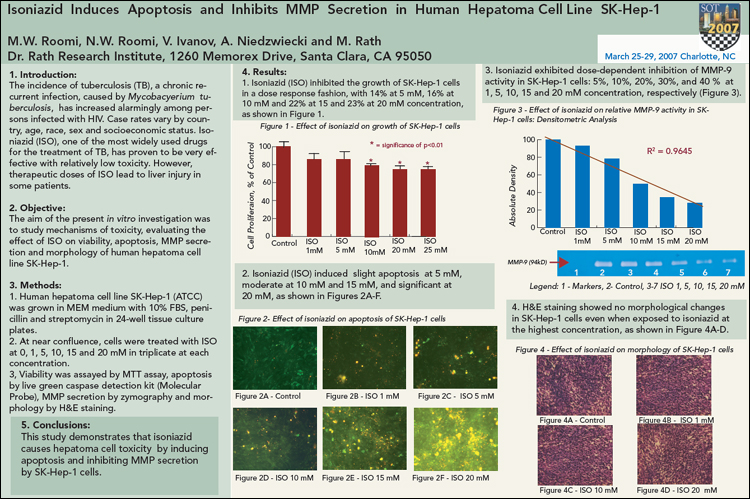M.W. Roomi, V. Ivanov, A. Niedzwiecki, M. Rath
Dr. Rath Research Institute, 1260 Memorex Drive, Santa Clara, CA 95050
Presented at:
46th Annual Meeting of Society of Toxicology, Charlotte, NC, March 25-29, 2007
Published in:
The Toxicologists (suppl Toxicological Sciences), Abstract #1001, pg 207, 2007.
Abstract
Introduction
The incidence of tuberculosis (TB), a chronic recurrent infection caused by Mycobacterium tuberculosis, has increased alarmingly among persons infected with HIV. Case rates vary by country, age, race, sex and socioeconomic status. Isoniazid (INH), one of the most widely used drugs for the treatment of TB, has proven to be very effective with relatively low toxicity. However, therapeutic doses of INH lead to liver injury in some patients.
Objective
The aim of the present in vitro investigation was to study mechanisms of toxicity, evaluating the effect of INH on viability, apoptosis, MMP secretion and morphology of human hepatoma cell line SK-Hep-1.
Methods
Human hepatoma cell line SK-Hep-1 (ATCC) was grown in MEM medium with 10% FBS, penicillin and streptomycin in 24-well tissue culture plates. At near confluence, cells were treated with INH at 0, 1, 5, 10, 15 and 20 mM in triplicate at each concentration. Viability was assayed by MTT assay, apoptosis using live green caspase detection kit (Molecular Probe), MMP secretion by zymography and morphology by H&E staining.
Results
INH inhibited the growth of SK-Hep-1 cells in a dose response fashion, 10% at 5 mM, 20% at 10 mM and 25% at 15 and 20 mM concentration. INH induced slight apoptosis at 5 mM, moderate at 10 and 15 mM and significant at 20 mM. INH also showed a dose-dependent inhibition of MMP-9 activity, 5%, 10%, 20%, 30%, and 40 % at 1, 5, 10, 15 and 20 mM concentration. H&E staining showed no morphological changes even at highest concentration.
Conclusions
The present study demonstrates that INH causes toxicity by inducing apoptosis and inhibiting MMP secretion.
Comment
Isoniazid (INH), a drug commonly used for treatment of tuberculosis, may lead to liver injury in some patients. We studied the mechanisms of INH toxicity using human hepatoma cell line SK-Hep-1. The present study demonstrated that INH causes toxicity to SK-Hep-1 cells by inducing apoptosis and inhibiting MMP secretion.
